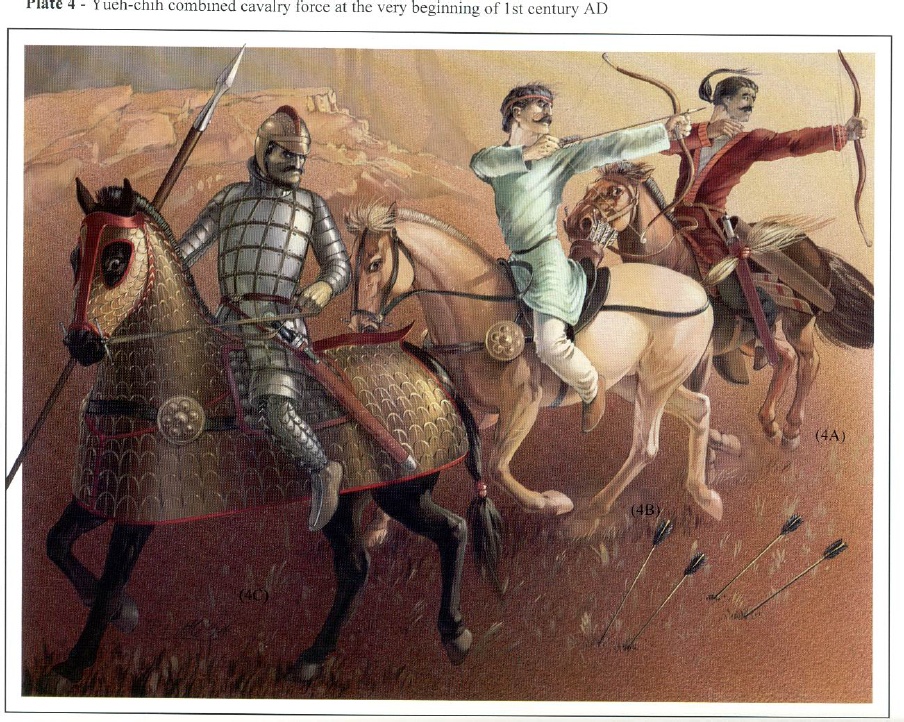
Register a SNAP EBT card with Amazon
Plate 4 Yüeh-chih cavalry in The Armies of Bactria 700BC-450AD Volume 2 (Illustrations) by Valerii P Nikonorov.
Colour Plates by Rory Little



Plate 4 - Yüeh-chih combined cavalry force at the very beginning of 1st century AD
(4A-B) Lightly armed horse-archers
(4C) Heavily outfitted cavalryman- cataphractarius
Reconstructions of the mounted archers are based on the ivory casket panel from Takht-i Sangin (4A, see Fig 27a) and on the sculptural fragments from Khalchayan (4B, see Fig 29; compare 31a as well). The warrior (4A), dressed in a long caftan, has a compound bow with long stiffened ears, which belongs to the so-called "Sasanian" type (see Fig 44m-o), a long sheathed sword and quiver, both suspended from his waist-belt.
The bowman (4B), wearing a long belted shirt, carries a long, double arched compound bow of the so-called "Hun" type (see Fig 44p), which is shown here speculatively, being a weapon that could have been brought to Bactria by the Yüeh-chih tribal coalition from the Central Asian steppes, where such bows must have already been in use. A bow of this type, dating from the first half of 1st millennium AD, was found in a catacomb burial of the Kenkol cemetery in Kirghizstan (see Fig 44q). The unique saddle with a rigid framework (perhaps made of wood), is known in the period under review solely thanks to the Khalchayan sculptural piece (see Fig 29h). Note the differences between the bowmen's hair-styles, which may indicate various Yüeh-chih tribes or clans. The painted sculpture from Khalchayan suggests that clothes were typically made of white cotton and red wool, although one figure, a ruler, wears what might be called "aquamarine".
The cataphractarius (4C) is based on the sculptural fragments from Khalchayan (Fig 30), our reconstruction differing from an earlier one by G A Pugachenkova (Fig 31a,b) in some important details, such as the warrior's leg-guards and his horse's armoured trapper. The rider's long corselet and arm-guards are here identical in their constructions with those depicted on the Indo-Saca coins (Fig 26a,c,d). As to his head-protector, it seems to be of the so-called "ridge" style, provided with a low fore-and-aft crest or ridge piece, as well as with a forehead peak and cheek-pieces. The leg-guards, reconstructed after a very small fragment (Fig 30e), consist of two parts. The upper one is a short "tube" of iron hoops encasing the lower portion of the thigh and reaching the knee (note that the Khalchayan armoured coat is slightly shorter than the lndo-Saca one and therefore it does not cover the whole thigh). The other part consists of trousers armoured by vertical strips of iron scales, however, the central strip is different, namely being of dark leather; it is reinforced by very small, tick-shaped iron plaques forming a herringbone design. It goes without saying that this reconstruction is very tentative. The horse-armour, as depicted in the sculpture (Fig 30c,d), comprises three items: a head-mask of armoured bronze scales; a neck-defence (Greek peritrakhelion) composed of a fabric or leather lining armoured by vertical rows of big bronze scales provided with longitudinal ribs for hardness; an armoured trapper which, in our speculative reconstruction, is of the same construction as the neck-defence; they both are fastened together by means of leather laces. As regards the horseman's offensive weapons, missing from the sculpture, they were hardly likely to be different from the standard cataphract heavy contus and long sword.
Source: The Armies of Bactria 700BC-450AD Volume 2 (Illustrations) by Valerii P Nikonorov